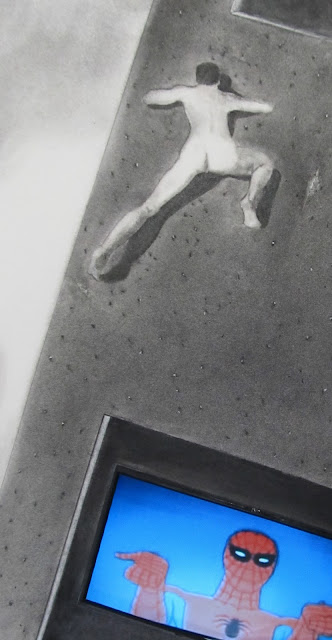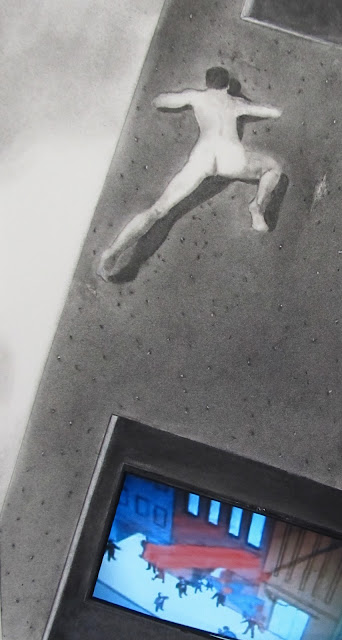Tuesday, December 17, 2013
Monday, December 16, 2013
What's in a name...
This post is truly the result of me finding some slides from 1980 and 1981, which is when I was doing some artwork about identity and labeling and ethnicity, etc. when I was a student at the University of Washington School of Art in Seattle, Washington.
I've been recently trying to digitize my art slides, and to my distress, I've been finding out that some of those slide-holding binders have succumbed to mold and moisture, and those two moist diseases have robbed me of a lot of my own artistic history.
I am sure that the fact that between 1980 and now I've moved about 30 times, including twice to Europe and back, has something to do with it, but it still sucks.

"Las Siete Fridas (The Seven Fridas)"
Pen and Ink Wash, F. Lennox Campello
Univ. of Washington Art School assignment circa 1980-1981
Collection of Seeds for Peace.
What hurt the most was the loss of slides documenting a series of pen and ink drawings, such as the above one, that I did on the thematic focus of surnames and what immediate impact is attached to them as soon as people hear them. Most of them, except for the dozen or so Frida pieces such as the one above, were sold at the Pike Place Market in Seattle, which is where I used to sell my art school assignments back then. The last name identity series was anchored around my documented passion for Frida Kahlo, and we must remember that not too many people outside of a certain artistic sphere was familiar with her back then... certainly not too many of my fellow Washington art students knew about her and her work back then.
Her last name gave rise to some interesting questions about her... "She was Mexican?" was a common question after I gave her name at a class review or talk... I knew that it was the last name throwing them off... a Mexican whose last name was Kahlo?
Having been raised in two distinct places of immense ethnic and racial diversity (Easternmost Cuba and Brooklyn) I was a little surprised at their surprise. "How can she be Mexican with a German (well, really Austrian... but) last name?" they might as well have asked... some did.
And so, starting in my junior year (I think) I commenced a series of portraits of faces migrating across a spectrum of ethnic, racial, cultural and even fantasy diversity. The Seven Fridas is a good example of that... as we see her as Nordic, Moslem, African, Punk, Native American, Vulcan and Beatle.
Many of the pieces were akin to this one, but the portraits were of either some fellow students, or sometimes borrowed from popular imagery. And they had titles such as "Portraits of Peddrossah" instead of Pedrosa and Rhoddrighez instead of Rodriguez, and "The Seven Stages of Dellauhehrtah" instead of De La Huerta, etc.
As soon as a De La Huerta becomes a Dellauhehrtah, I discovered, his/her whole ethnicity, and in some cases, his/her race shifts tremendously, regardless of the race, ethnicity or national origin of both the subject and the ones being subjected to my name and visual puzzlement. By the way, to this day, that name/word does not exist in all of the Internets.
Get my drift?
The Kahlo name issue, was of course somewhat kindled by my own last name issue.
"Is that Italian?" is the question that I'm used to getting, except in New England, where it is usually a more blunt "What are you?"
I've been recently trying to digitize my art slides, and to my distress, I've been finding out that some of those slide-holding binders have succumbed to mold and moisture, and those two moist diseases have robbed me of a lot of my own artistic history.
I am sure that the fact that between 1980 and now I've moved about 30 times, including twice to Europe and back, has something to do with it, but it still sucks.
"Las Siete Fridas (The Seven Fridas)"
Pen and Ink Wash, F. Lennox Campello
Univ. of Washington Art School assignment circa 1980-1981
Collection of Seeds for Peace.
As soon as a De La Huerta becomes a Dellauhehrtah, I discovered, his/her whole ethnicity, and in some cases, his/her race shifts tremendously, regardless of the race, ethnicity or national origin of both the subject and the ones being subjected to my name and visual puzzlement. By the way, to this day, that name/word does not exist in all of the Internets.
Sunday, December 15, 2013
PLAY BY PLAY at Project 4
Project 4 will host Play by Play, a pop-up FLEX focus collaboration developed by guest curator Kayleigh Bryant. The show runs Jan 11 - Feb 1, 2014, with an opening reception Saturday, Jan. 11 from 7-9PM.
This exploration of the darker side of children's playtime features the work of Amy Hughes Braden, Bridget Sue Lambert, Janelle Whisenant, and Mark Williams. The sticky place between childhood innocence and adult realism is examined through different exercises in subverted play.
The artists in Play by Play dig into the malaise, mediocrity, sexuality, and violence implied by commonplace toys and imagery of childhood by re-appropriating these objects within complex juxtapositions of adult ideals. Braden's paintings of children and families offer a stark glimpse into the transitional moment straddling childhood and adulthood. Lambert's staged doll and dollhouse photography exposes the sexual and sexist implications of such toys. Whisenant's mutant stuffed-animal creatures question the cycle of childhood materiality. Williams' toy soldiers mock the implied oversimplification of war as a child's play.
FLEX
is a group of artists and curators who come together to produce a
series of exciting temporary exhibitions. Focusing on projects that do
not rely on a stationary base of operations, FLEX is able to adapt to
different locations to engage a variety of audiences and contexts.
FLEX's loose framework provides a platform for an ever-changing cast of
independent curators and artists to test the boundaries of visual
expression and probe new ways of connecting with the viewer. As an open
model, FLEX allows exhibitions to be dynamic and adapt to the spaces
they inhabit. Mobile gallery spaces, outdoor projection units,
site-specific installations, drawing machines, and 3D Printing are some
of the tactics employed. The curator, Kayleigh Bryant is a young Washington, DC-based curator, arts professional and freelance arts critic for outlets including Examiner.com, CBS Local DC Online and Brightest Young Things.com.
Saturday, December 14, 2013
Friday, December 13, 2013
Lessons learned at AU
American University was locked down on Wednesday night when a person with a gun was spotted on campus at the same time that faculty member Alida Anderson and her class of future teachers were undertaking their final presentations for the semester. Alida’s course was taking place ...Read the WaPo story here...
AU now has the opportunity to do a full scrub on this issue and gather some great lessons learned from this event... one clear one is that something easy and simple has to be developed and placed in each classroom to allow the class to lock the doors from the inside... but in any event, I am very proud of my wife!
Thursday, December 12, 2013
Subscribe to:
Posts (Atom)






